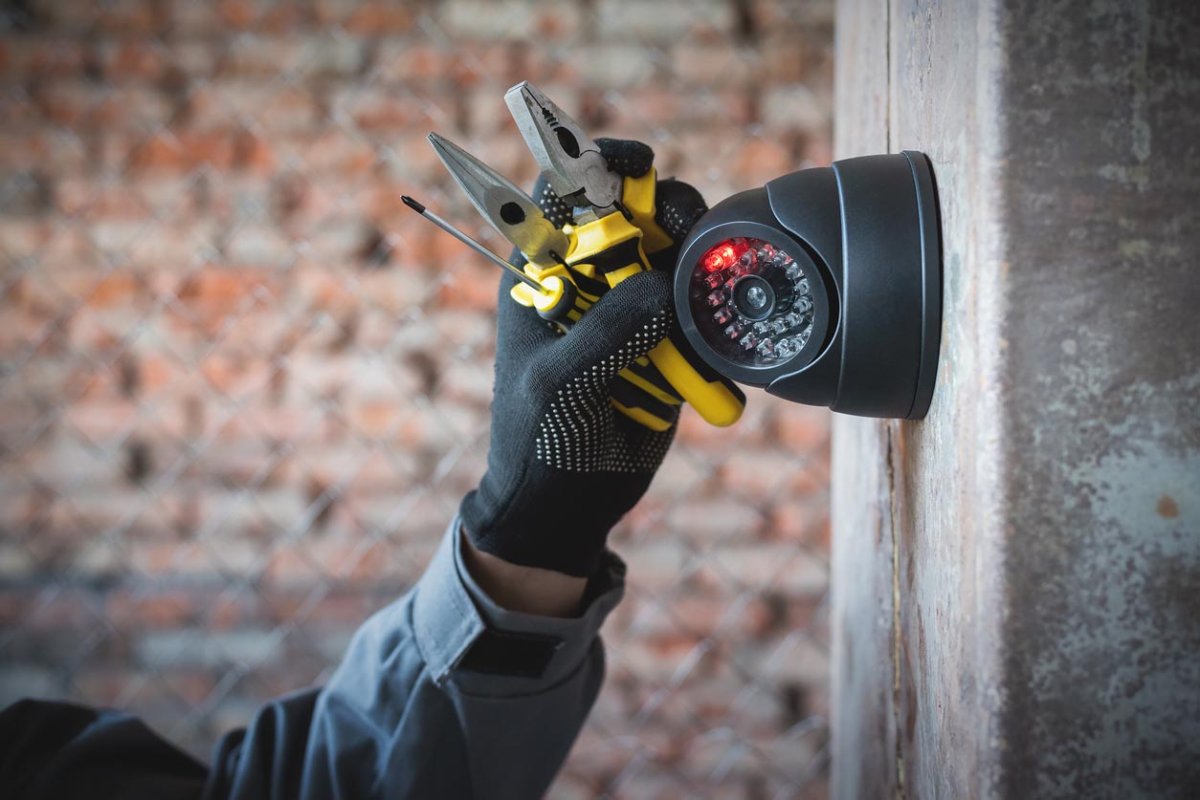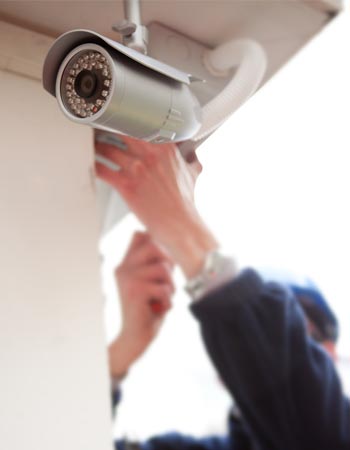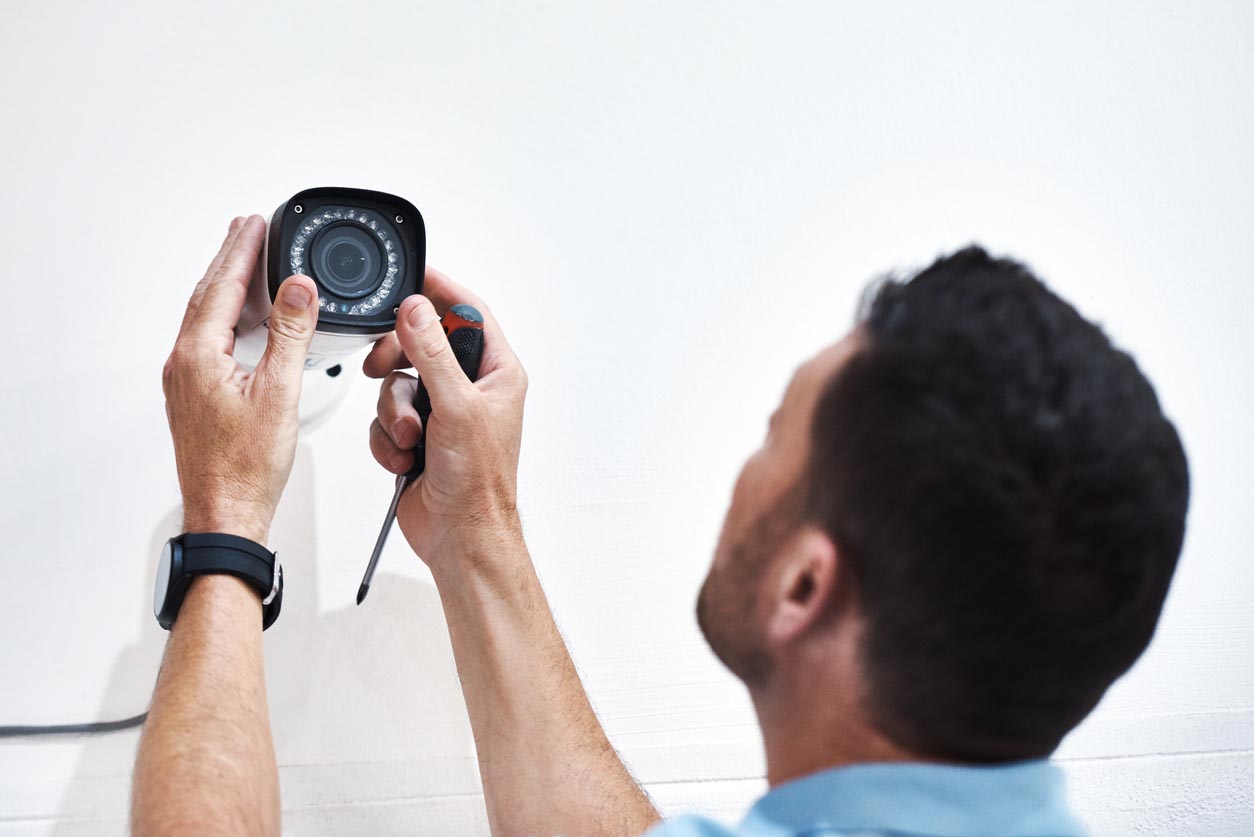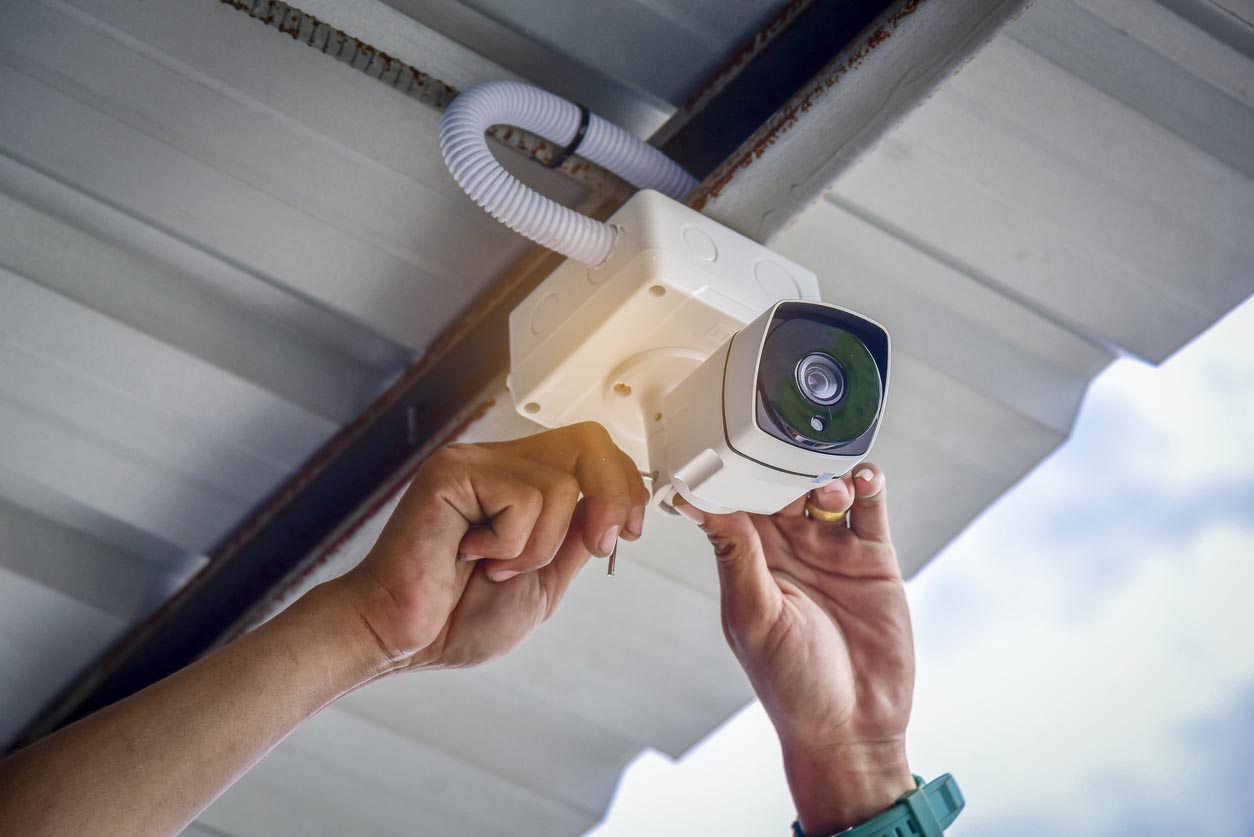

We may earn revenue from the products available on this page and participate in affiliate programs. Learn More ›
Take a good look at your home. Where do you feel you need video coverage? Is there a dark space you can’t quite see from the window that would make a perfect hideout for a criminal? Is there a back door that locks securely but leads to a swimming pool gate that your industrious toddler is entranced by? Installing security cameras can go a long way toward making residents feel secure in their homes, but they need to be positioned correctly in logical places that provide footage of trouble spots. The first thing residents need is a plan to install a security camera system.
Residents can start by making a quick sketch of the home and starting to plan out where they feel they would need to position cameras. As they consider all the steps necessary for installation, residents can make notes on this sketch about distances to power sources, the location of existing wiring that may be in the way, and how far the Wi-Fi router and extenders are from each potential camera location. They’ll want to think about the types of cameras they may need and any additional supplies required to complete the camera installation. Then the plan will be complete, and the resident can get started. Home security camera installation can be a DIY project, but many residents might find it easier to hire a professional to do the job.
Understanding more about security camera systems installation, including how to install security camera wiring and how to install outdoor security cameras, will help residents decide whether they want to take this project on by themselves or hire someone to help.
Before You Begin…

Security camera installation isn’t inherently difficult, but depending on the type and location of the cameras, residents will need to do some safety checks before they begin.
First, they will need to gather some tools and supplies. A drill (preferably cordless, as the resident will likely be on a ladder while using it), along with Phillips-head and flathead screwdrivers and some needle-nose pliers will be necessary, but residents will also need to consider supplies for the type of surface on which they’ll install the cameras. If they will need to drill into brick, a hammer drill and/or masonry drill bits may be necessary in order to secure the cameras into a brick surface without splitting or breaking the brick. The resident will also need a ladder—or several, depending on the height of the roofline and the selected installation locations. Those installing a wired camera may also need fish tape, which is used for dragging cables through walls without drilling unnecessary holes in the drywall or plaster, along with electrical supplies if the cameras aren’t battery-powered. Most will be included in the package that comes with the camera, but depending on the specific installation situation, the resident may want to consider picking up some extra electrical tape, and for outdoor installations, a tube of caulk or sealant will ensure a leak-free bond.
Residents will want to remember that it’s key to check for wiring that may be behind walls, ceilings, or roofs before drilling into any surface.
When installing a wired camera, the resident will want to make absolutely certain that the power is turned off at the breaker box, even if the camera is battery-powered and they’re just running a cable through conduit to an existing outlet. Anytime someone is working inside the walls, the power needs to be turned off. Also, if the camera is hard-wired into the electrical system, it’s a good idea to find out whether the wiring project requires a permit and if so, leave time in the plan to apply for, pay for, and pick up the permit.
If the resident is installing cameras on a second story or tall roofline, it’s important to take basic ladder safety precautions. Make sure that the ladder is on stable ground and is properly extended or secured against the building before climbing, far away from any electrical or cable wiring. Having a friend on hand to stabilize the ladder and help is a good plan as well.
Finally, if all of this seems overwhelming to the resident or a bit beyond their skills, they may want to consider calling in a professional. Paying a security camera installer to do the job could save residents a number of trips back and forth to the hardware store—or the emergency room. The cost to have security cameras installed averages between $150 and $2,040, depending on the type and number of cameras to be connected. Residents may find it’s well worth it, especially if they’re not comfortable on a ladder or dealing with electrical systems. Who installs security cameras in a home? Security companies often have installers available, and other security professionals often provide this service freelance. In many cases, a handyman or electrician can also do the job. Other installers may focus on surveillance camera installation or business security camera system installation. Searching for “home security system installers near me” will help narrow down the options.
STEP 1: Choose the type and brand of security cameras that work best for you.
There are several different brands of cameras available on the market; some can be purchased through a home security company, others are purchased separately to integrate with an existing system or to work on their own. How to choose? First, the resident will want to identify any existing security systems in the home, find out if they work, and establish whether they want to build on that system or start fresh. This will help determine if they need to stick with a particular brand that’s compatible with the existing system. Next, they can consider any smart-home devices or smart-home assistants that are currently installed; many cameras on the market are compatible with Google Assistant, Amazon Alexa, and Apple Siri and can tie into an app-controlled smart-home system that includes lighting, door locks, appliances, and HVAC. There’s an appeal to starting fresh with a new system from one of the best home security companies, but it makes sense to check the brands that work with what the home already has as well.
What is the difference between the different types of cameras? The first important decision is whether wired or wireless cameras are preferable. Wireless cameras use the home’s Wi-Fi to transmit images and videos to a physical or cloud-based recording device. Wired cameras, on the other hand, use coaxial or Cat-5 cable to directly connect to a physical recording device. These are less vulnerable to hackers, but they do require some extra expense and installation effort. The terms “wired” and “wireless” don’t refer to power—they refer to data transmission. Both wired and wireless cameras can be powered by rechargeable or replaceable batteries or can be hardwired into the home’s electrical system.
In general, wireless cameras are easiest to install. There’s no need to thread coaxial or data cables through walls and engage in wiring electrical boxes or patching drywall after working a plug through to an outlet. But some worry about hackers breaking into their Wi-Fi and viewing the home’s interior via the camera feeds. Wired cameras don’t have this vulnerability. Battery-powered cameras continue to function during power outages, which hardwired cameras do not. That said, if the camera location requires an extension ladder and a precarious path across a roof to install, changing or charging batteries can turn into an inconvenience and potentially a hazard, so in those cases choosing a hardwired camera might make more sense.

STEP 2: Decide where you want to place the cameras.
Some people want to cover the entirety of their property with cameras and be able to scroll through the feeds, similar to a CCTV camera installation for surveillance. Others just want to be able to check on the front door when they’re not home, and there are many steps in between. Traditionally, the best outdoor wireless security camera systems are installed to cover the obvious entry points to the home, such as the front and back entry doors, vulnerable first-floor windows, and the garage door. Some people choose to include cameras that cover the front and back yard; connecting those cameras to motion-sensor lights or using one of the best night-vision cameras can make it easier to monitor activity in the darker recesses of the yard overnight and discourage criminals from making trouble to begin with.
While many people don’t initially consider adding indoor cameras, there are quite a few benefits to determining where to place security cameras indoors strategically so they can monitor pets, children who are home alone, or older residents who are prone to health problems or falls. Generally, cameras should not be placed in bedrooms or bathrooms (even if that’s where the greatest fall risk is) for privacy reasons, but as many thieves know that the primary bedroom is the most likely hiding spot for valuables, residents can consider positioning a camera just outside the primary bedroom door.
Outdoor cameras should be mounted high enough that would-be criminals can’t easily access them to disable them, and they should be protected somewhat from wind and weather where necessary. Residents will want to keep in mind that to adjust the angle of the camera or change the batteries, someone will need to be able to access it, so they’ll need to balance the desire for a bird’s-eye view against the inconvenience and potential danger of accessing the camera. It’s a good idea for residents to be aware of blind spots and making sure the camera’s eye won’t be blinded by direct sunlight (or a streetlight) and impact the quality of the video.
STEP 3: If using wireless cameras, mount them on a solid surface using the equipment provided in the kit.
Most cameras include a range of mounting equipment in the box they come with. Wireless cameras can be fairly easy to install: The kit will include a mounting bracket that is firmly screwed into a wall or roof. If mounting on a roof, residents may want to consider adding a bead of sealant under the bracket or around the screws to make sure they’re not creating leaks through the shingles. They will need to make certain that the surface is sturdy and solid, and that they’re able to use all of the fasteners recommended by the manufacturer. If the surface is unsteady, the video feed will be shaky and likely useless. If the wireless camera needs to be plugged in or hardwired to the electrical system, now is the time to create a path for the power cables to be connected or plugged in. Some people choose to install a dedicated power outlet on the home’s exterior or under an access panel nearby, while others choose to pull power lines through the walls of the home and hardwire them in at a nearby outlet indoors.
STEP 4: If using wired cameras, mount the cameras and run the cables to the DVR box.
Wired security cameras installation kits will also include a mounting bracket that should be secured to a solid surface, but before any connections can take place, there’s some wiring work to do. Data cables (usually either coaxial or Cat-5 cables) will need to be run from the camera’s location to the digital video recorder box (DVR). Depending on where the camera is located, this can be as straightforward as running the cable through a bit of decorative conduit and along the baseboard, but it may also be as complicated as fishing cable through the roof, across crawl spaces, and through walls. It’s important to take care not to disturb other wiring within the walls while threading this cable, or the resident may find themselves with a bigger project than anticipated.
Pulling cables through walls isn’t as easy as plugging in a cord; there are many potential problems when cutting into walls or fishing cables through insulation and potential wire tangles. If this isn’t a process the resident has done before, it may be worth hiring someone with experience who knows how to install wired security cameras.

STEP 5: Install the cameras into the mounts and attach to the power source, if applicable.
Once any necessary wiring is complete, it’s time to secure the cameras into their mounting brackets. Residents will want to take the time now to make sure that any set screws are tightly in place without tightening down the screws that hold the camera’s angle in place just yet. They’ll also want to connect the camera to the power cables, if that’s the plan, or install new, fresh, long-lasting batteries as recommended by the manufacturer. For exterior installations, residents will want to make sure that any electrical connections are properly connected, sealed, and protected from the weather before completing the job.
STEP 6: If the camera comes with a hub, make sure it is placed within the correct distance of the hub so it will connect.
Depending on where the cameras are located, they may be too far from the home’s Wi-Fi router to create a strong connection, especially if the cameras are outdoors. In these cases, there are two options: Residents can add a range extender to the router, or they can use a hub designed to work with the brand of camera they’ve purchased. Hubs catch the signal between the router and the camera and boost it between the two. As cameras frequently need to be within 100 feet of a router, extender, or hub, the hubs may need to be readjusted after the cameras are affixed.
STEP 7: Position the cameras to ensure they cover the area you want to monitor.
Before tightening the final screws to hold the cameras at the correct angle, residents will want to take the time to make sure they’re covering what they’d planned for them to cover. Residents can place their eye behind the camera and point it at the center of the area they want the camera to cover. It’s a good idea to secure the screws that hold the angle in place without tightening them quite yet. The best point-of-entry security camera systems will have a clear view of the home’s front and back doors, while indoor cameras may monitor living areas.
STEP 8: Connect the security cameras to your home network.
For residents who are using a wireless camera, now is the time to fire up the app or a computer to connect the cameras to the Wi-Fi network. The exact instructions for camera setup will vary based on the brand, but the instructions included with the cameras are typically straightforward. If the resident is invited to select a password to protect the connection at this stage, they’ll want to make sure it’s a strong one that isn’t easy to guess; ideally, they will have a strong password for the Wi-Fi router and home network as well, but this password shouldn’t be the same as those.
If the resident is using a wired camera, they’ll need to connect the cable that they’ve run from the camera to the router. Coaxial cable will simply screw in, while Cat 5 cable will plug in securely with a small snap. Residents will want to make sure all cables are completely seated in their ports for the strongest and clearest connection.

STEP 9: Open the home security app (if available) to check that the cameras are working properly.
Once everything is connected, it’s time for the resident to open the app that came with the home security system or the cameras and see what they can see. They’ll want to look carefully at the images and check for blind spots or angles that aren’t quite correct. This may take several tries to get exactly right: A little movement in any direction can create a new blind spot or zero in on the desired view.
STEP 10: Tighten down the cameras in the position that you’ve selected and complete the installation.
Once the resident is sure that the cameras are capturing all of the areas they want them to, it’s time to tighten down the final screws that secure the camera’s angles in place. This is also the time to take care of any finishing work around the installation, including caulking any small gaps around an exterior mounting bracket or block, filling or patching any holes created while running wires, and adding faceplates to connections or outlets. Once the cameras are secured in place, the resident can check the video feed again to make sure that the cameras are pointing exactly where they need to be, then put away the tools and equipment. Everything that’s left is electronic.
STEP 11: Customize the camera settings via the app.
Depending on the cameras chosen, the resident will have some decisions to make about different setting options. Cameras that are motion activated have a setting that allows the user to customize the sensitivity—and this is an important setting, because it will determine whether the camera begins recording only when there’s a person nearby, or if it triggers every time a stray cat wanders into the yard. Why does this matter? Most systems have a limit on the video storage capacity, and no one wants to fill the storage with images of stray cats and run out just when there’s a genuine danger present. In addition, keeping the cameras at a too-high sensitivity setting will waste the battery power on cameras that aren’t hardwired, reducing their lifespan.
Other settings may include night-vision options, video quality, facial recognition, and scheduled backups and deletions of saved video. Residents can review the instructions that came with the system to make sure they’ve checked all of the settings before using the cameras.
STEP 12: Sync the security system with other connected devices in your home, such as smart sensors.
If the cameras are compatible with other connected devices or a larger home security system, the resident may have additional options for viewing and controlling the cameras. For example, they may be able to watch the camera feed on a smart TV or use a voice-activated assistant to control the camera. Smart-home assistants may allow conditional responses to motion; for instance, if the camera is triggered by motion, the system can be programmed to turn on lights outdoors and in the first floor of the home in response. Syncing the system lets all of the components of the security system work together to create a secure envelope around and inside the home, whether the residents are home or not.
STEP 13: If you need assistance, contact a professional to help install the cameras.
Security camera system installation isn’t terribly difficult, but it’s not a small project, and it requires comfort with visualizing angles, climbing to some heights, and dealing with wiring, cables, and connectivity. If that’s something the home’s residents aren’t comfortable with, there are security camera installers who can help for a fairly minimal cost. Choosing to hire professional help can save a lot of frustration—there are few things more irritating than spending a day climbing and drilling and connecting only to flip the switch and see…nothing. If this happens, residents can call a professional who knows how to hook up a security camera to help them find the problem and fix it. There’s a reason many home security companies still require that their technicians install cameras and sensors. While installing one or two wireless, battery-powered cameras isn’t a big deal, the larger the system gets, the more complex the plan.
Whether residents are installing a single camera to improve front door security or monitor a window, or they’re installing a complex network of synced cameras, lights, and sensors, the process is fairly clear. This can be a DIY project, but if the resident can’t (or would prefer not to) do it themselves, there are many professionals ready to tackle it for them. Regardless of who does the installation, security cameras are generally a worthwhile investment to deter criminals from even approaching a home (they don’t want to be caught on camera, after all), and cameras can give a home’s residents time to get to safety in case of danger and hopefully help bring the perpetrators to justice afterward. Combining security cameras with other simple security measures such as good lighting, strong deadbolts, and open lines of sight around entrances and windows will secure the home and let residents sleep better at night.
